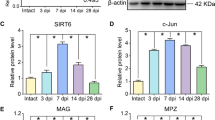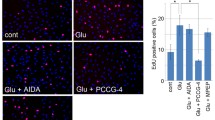Abstract
Src-suppressed protein kinase C substrate (SSeCKS) plays an important role in the differentiation process. In regeneration of sciatic nerve injury, expression of SSeCKS decreases, mainly in Schwann cells. However, the function of SSeCKS in Schwann cells differentiation remains unclear. We observed that SSeCKS was decreased in differentiated Schwann cells. In long-term SSeCKS-reduced Schwann cells, cell morphology changed and myelin gene expression induced by cAMP was accelerated. Myelination was also enhanced in SSeCKS-suppressed Schwann cells co-culture with dorsal root ganglion (DRG). In addition, we found suppression of SSeCKS expression promoted Akt serine 473 phosphorylation in cAMP-treated Schwann cells. In summary, our data indicated that SSeCKS was a negative regulator of myelinating glia differentiation.





Similar content being viewed by others
References
Arroyo EJ, Scherer SS (2000) On the molecular architecture of myelinated fibers. Histochem Cell Biol 113:1–18
Menichella DM et al (2001) Protein zero is necessary for E-cadherin-mediated adherens junction formation in Schwann cells. Mol Cell Neurosci 18:606–618
Bermingham JR Jr, Scherer SS, O’Connell S, Arroyo E, Kalla KA, Powell FL, Rosenfeld MG (1996) Tst-1/Oct-6/SCIP regulates a unique step in peripheral myelination and is required for normal respiration. Genes Dev 10:1751–1762
Jaegle M, Mandemakers W, Broos L, Zwart R, Karis A, Visser P, Grosveld F, Meijer D (1996) The POU factor Oct-6 and Schwann cell differentiation. Science 273:507–510
Monuki ES, Weinmaster G, Kuhn R, Lemke G (1989) SCIP: a glial POU domain gene regulated by cyclic AMP. Neuron 3:783–793
Mirsky R et al (2001) Regulation of genes involved in Schwann cell development and differentiation. Prog Brain Res 132:3–11
Bermingham JR Jr et al (2006) The claw paw mutation reveals a role for Lgi4 in peripheral nerve development. Nat Neurosci 9:76–84
Ogata T, Iijima S, Hoshikawa S, Miura T, Yamamoto S, Oda H, Nakamura K, Tanaka S (2004) Opposing extracellular signal-regulated kinase and Akt pathways control Schwann cell myelination. J Neurosci 24:6724–6732
Sobue G, Pleasure D (1984) Schwann cell galactocerebroside induced by derivatives of adenosine 3′, 5′-monophosphate. Science 224:72–74
Lemke G, Chao M (1988) Axons regulate Schwann cell expression of the major myelin and NGF receptor genes. Development 102:499–504
Morgan L, Jessen KR, Mirsky R (1991) The effects of cAMP on differentiation of cultured Schwann cells: progression from an early phenotype (04+) to a myelin phenotype (P0+, GFAP-, N-CAM-, NGF-receptor-) depends on growth inhibition. J Cell Biol 112:457–467
Howe DG, McCarthy KD (2000) Retroviral inhibition of cAMP-dependent protein kinase inhibits myelination but not Schwann cell mitosis stimulated by interaction with neurons. J Neurosci 20:3513–3521
Frankfort BJ, Gelman IH (1995) Identification of novel cellular genes transcriptionally suppressed by v-src. Biochem Biophys Res Commun 206:916–926
Lin X, Tombler E, Nelson PJ, Ross M, Gelman IH (1996) A novel src- and ras-suppressed protein kinase C substrate associated with cytoskeletal architecture. J Biol Chem 271:28430–28438
Nauert JB, Klauck TM, Langeberg LK, Scott JD (1997) Gravin, an autoantigen recognized by serum from myasthenia gravis patients, is a kinase scaffold protein. Curr Biol 7:52–62
Grove BD, Bowditch R, Gordon T, del Zoppo G, Ginsberg MH (1994) Restricted endothelial cell expression of gravin in vivo. Anat Rec 239:231–242
Gelman IH (2002) The role of SSeCKS/gravin/AKAP12 scaffolding proteins in the spaciotemporal control of signaling pathways in oncogenesis and development. Front Biosci 7:d1782–d1797
Cheng C, Liu H, Ge H, Qian J, Qin J, Sun L, Shen A (2007) Essential role of Src suppressed C kinase substrates in endothelial cell adhesion and spreading. Biochem Biophys Res Commun 358:342–348
Nelson PJ, Gelman IH (1997) Cell-cycle regulated expression and serine phosphorylation of the myristylated protein kinase C substrate, SSeCKS: correlation with culture confluency, cell cycle phase and serum response. Mol Cell Biochem 175:233–241
Erlichman J, Gutierrez-Juarez R, Zucker S, Mei X, Orr GA (1999) Developmental expression of the protein kinase C substrate/binding protein (clone 72/SSeCKS) in rat testis identification as a scaffolding protein containing an A-kinase-anchoring domain which is expressed during late-stage spermatogenesis. Eur J Biochem 263:797–805
Chen L et al (2007) Developmental regulation of SSeCKS expression in rat brain. J Mol Neurosci 32:9–15
Chen L, Qin J, Cheng C, Niu S, Liu Y, Shi S, Liu H, Shen A (2008) Spatiotemporal expression of SSeCKS in injured rat sciatic nerve. Anat Rec (Hoboken) 291:527–537
Akakura S, Huang C, Nelson PJ, Foster B, Gelman IH (2008) Loss of the SSeCKS/Gravin/AKAP12 gene results in prostatic hyperplasia. Cancer Res 68:5096–5103
Jessen KR, Mirsky R (2002) Signals that determine Schwann cell identity. J Anat 200:367–376
Raff MC, Hornby-Smith A, Brockes JP (1978) Cyclic AMP as a mitogenic signal for cultured rat Schwann cells. Nature 273:672–673
Raff MC, Abney E, Brockes JP, Hornby-Smith A (1978) Schwann cell growth factors. Cell 15:813–822
Yamada H, Komiyama A, Suzuki K (1995) Schwann cell responses to forskolin and cyclic AMP analogues: comparative study of mouse and rat Schwann cells. Brain Res 681:97–104
Iacovelli J, Lopera J, Bott M, Baldwin E, Khaled A, Uddin N, Fernandez-Valle C (2007) Serum and forskolin cooperate to promote G1 progression in Schwann cells by differentially regulating cyclin D1, cyclin E1, and p27Kip expression. Glia 55:1638–1647
Monje PV, Bartlett Bunge M, Wood PM (2006) Cyclic AMP synergistically enhances neuregulin-dependent ERK and Akt activation and cell cycle progression in Schwann cells. Glia 53:649–659
Stork PJ, Schmitt JM (2002) Crosstalk between cAMP and MAP kinase signaling in the regulation of cell proliferation. Trends Cell Biol 12:258–266
Dumaz N, Marais R (2005) Integrating signals between cAMP and the RAS/RAF/MEK/ERK signalling pathways. Based on the anniversary prize of the Gesellschaft fur biochemie und molekularbiologie lecture delivered on 5 July 2003 at the special FEBS meeting in Brussels. Febs J 272:3491–3504
Iacovoni JS, Cohen SB, Berg T, Vogt PK (2004) v-Jun targets showing an expression pattern that correlates with the transformed cellular phenotype. Oncogene 23:5703–5706
Heinen A, Kremer D, Gottle P, Kruse F, Hasse B, Lehmann H, Hartung HP, Kury P (2008) The cyclin-dependent kinase inhibitor p57kip2 is a negative regulator of Schwann cell differentiation and in vitro myelination. Proc Natl Acad Sci USA 105:8748–8753
Acknowledgments
The authors wish to thank Dr. Yuxiang Hu for helpful criticism and linguistic revision of the manuscript. This work was supported by the National Natural Science Foundation of China (No. 30300099, No. 30770488, and No. 30870320); Natural Science Foundation of Jiangsu province (No. BK2006547, No. BK2009156, No. BK2009157, and No. BK2009161); Health Project of Jiangsu Province (H200632); Special Research Grant (XK200723) for the Key Laboratory from the Department of Health, Jiangsu Province; The Society and Technology Grew Project of Nantong City. (S2008020).
Author information
Authors and Affiliations
Corresponding authors
Additional information
Yuhong Ji and Tao Tao contributed equally to this work.
Rights and permissions
About this article
Cite this article
Ji, Y., Tao, T., Cheng, C. et al. SSeCKS is a Suppressor in Schwann Cell Differentiation and Myelination. Neurochem Res 35, 219–226 (2010). https://doi.org/10.1007/s11064-009-0045-2
Received:
Accepted:
Published:
Issue Date:
DOI: https://doi.org/10.1007/s11064-009-0045-2




